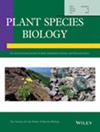高山兰花 Platanthera tipuloides 的夜蛾授粉现象
IF 1.3
4区 生物学
Q4 ECOLOGY
引用次数: 0
摘要
高山植物的授粉成功率往往受制于恶劣和不稳定的天气条件,授粉者的活动少且难以预测,夜间授粉更是罕见。高山兰花 Platanthera tipuloides(兰科)的黄绿色花朵并不显眼,带有甜香,长长的花刺中含有花蜜。预计这些花朵特征与夜蛾授粉有关。为了弄清该物种的授粉模式和繁殖特征,我们在日本北部大雪山的两个研究地块测量了花的特征(花刺长度、花刺中的花蜜含量、花香),使用相机陷阱记录了访花者,并通过控制授粉量化了自交和花粉限制程度。研究结果表明,在其中一块研究地块中,尖叶桉属植物具有自交不亲和特性,且不存在花粉限制。花朵在夜间释放出更多的挥发性物质,包括丁香醛异构体,众所周知,丁香醛异构体能吸引飞蛾。研究人员观察到一种夜蛾 Entephria amplicosta 在花丛中觅食花蜜,但没有观察到昼伏夜出的访客。E. amplicosta 的长鼻短于花刺的长度,但其长度足以取用花刺中积累的花蜜。这些结果表明,即使在环境条件恶劣的高山生态系统中,飞蛾也可以进行夜间授粉,而且效率很高。本文章由计算机程序翻译,如有差异,请以英文原文为准。
Nocturnal moth pollination in an alpine orchid, Platanthera tipuloides
Pollination success of alpine plants is often restricted by low and unpredictable pollinator activity because of harsh and unstable weather conditions, where nocturnal pollination is rare. The alpine orchid, Platanthera tipuloides (Orchidaceae), has inconspicuous greenish yellow flowers with a sweet scent and a long spur that contains nectar. These floral traits are expected to be related to nocturnal moth pollination. To elucidate the pollination mode and reproductive characteristics of this species, we measured floral traits (spur length, nectar content in the spur, floral scent), documented flower visitors using camera traps, and quantified self‐compatibility and the degree of pollen limitation through controlled pollinations at two study plots in the Taisetsu Mountains, northern Japan. It was revealed that P. tipuloides is self‐incompatible and pollen limitation was absent at one of the study plots. The flowers emitted more volatile substances during the night, including lilac aldehyde isomers, which are known to attract moths. A nocturnal moth, Entephria amplicosta , was observed foraging nectar from the flowers, while no diurnal visitors were observed. The proboscis of E. amplicosta was shorter than the spur length, but it was long enough to access the accumulated nectar in the spurs. These results suggest that nocturnal pollination by moths is possible and can be efficient even in an alpine ecosystem with harsh environmental conditions.
求助全文
通过发布文献求助,成功后即可免费获取论文全文。
去求助
来源期刊

Plant Species Biology
生物-生态学
CiteScore
2.70
自引率
14.30%
发文量
36
审稿时长
>12 weeks
期刊介绍:
Plant Species Biology is published four times a year by The Society for the Study of Species Biology. Plant Species Biology publishes research manuscripts in the fields of population biology, pollination biology, evolutionary ecology, biosystematics, co-evolution, and any other related fields in biology. In addition to full length papers, the journal also includes short research papers as notes and comments. Invited articles may be accepted or occasion at the request of the Editorial Board. Manuscripts should contain new results of empirical and/or theoretical investigations concerning facts, processes, mechanisms or concepts of evolutionary as well as biological phenomena. Papers that are purely descriptive are not suitable for this journal. Notes & comments of the following contents will not be accepted for publication: Development of DNA markers. The journal is introducing ''Life history monographs of Japanese plant species''. The journal is dedicated to minimizing the time between submission, review and publication and to providing a high quality forum for original research in Plant Species Biology.
 求助内容:
求助内容: 应助结果提醒方式:
应助结果提醒方式:


